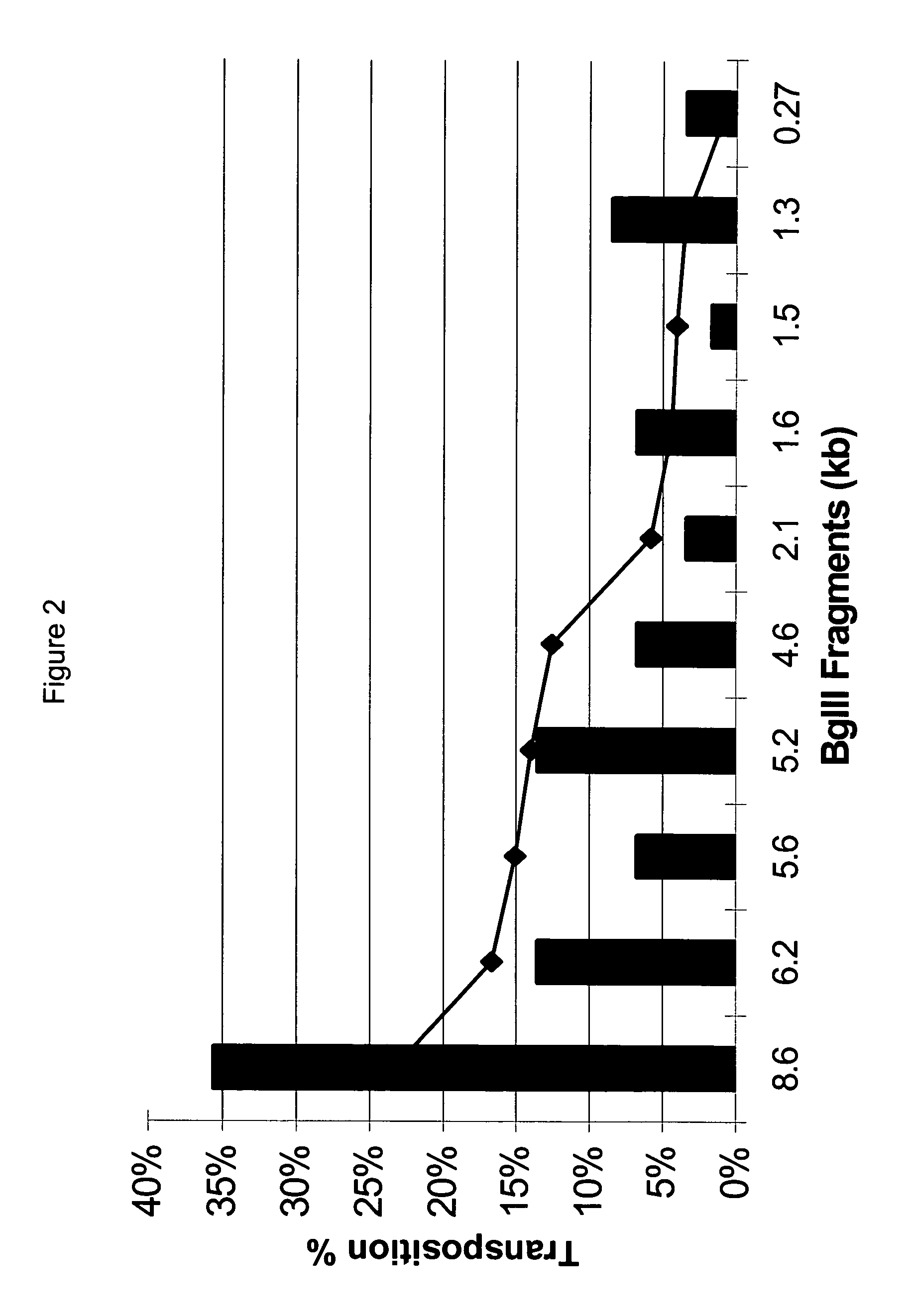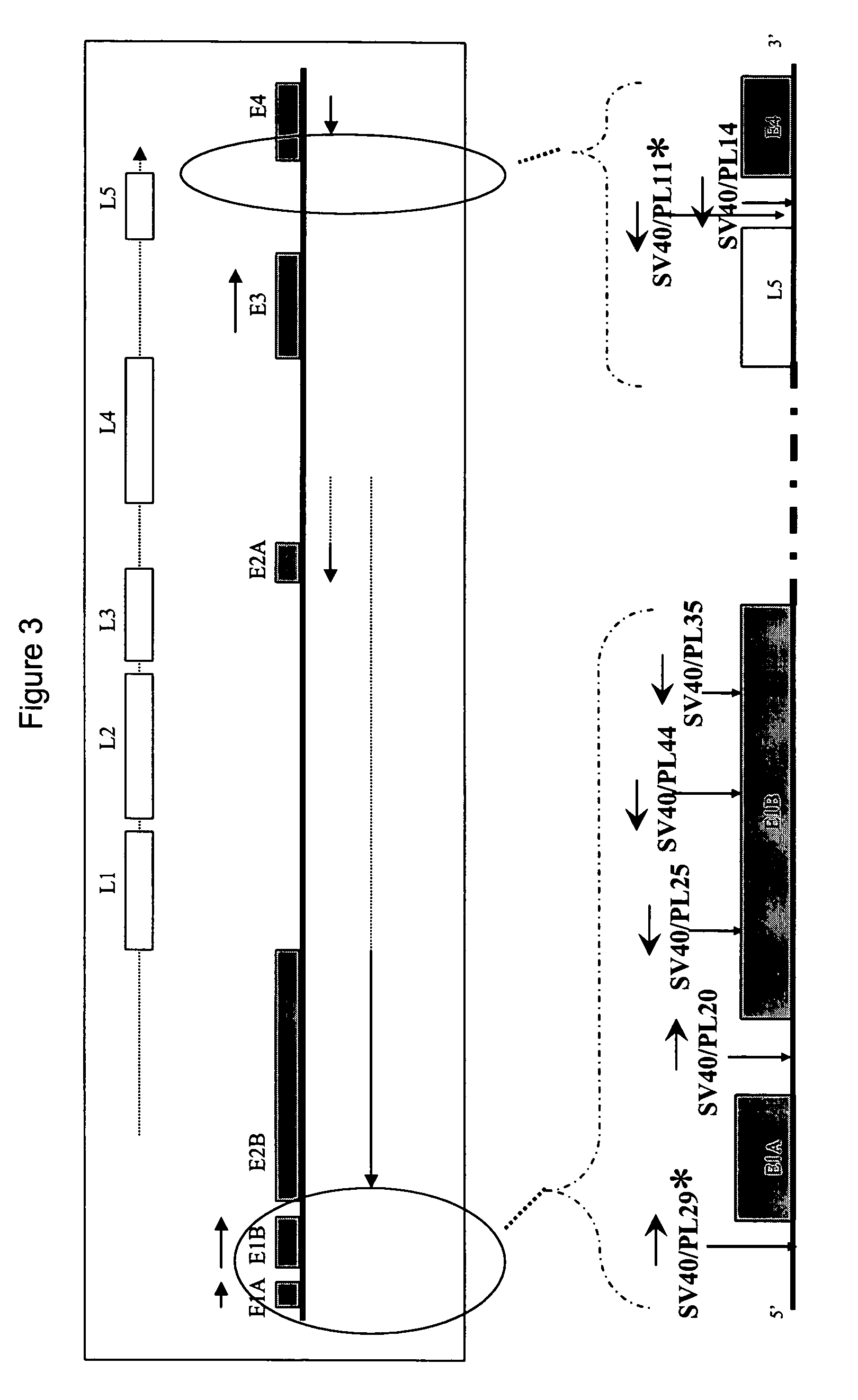Generation of replication competent viruses for therapeutic use
a technology of replication competent virus and therapeutic use, which is applied in the manufacture of genetic therapy compositions, viruses, vectors, etc., can solve the problems of limited selection of insertion sites for therapeutic genes, limited usefulness of replication-defective vectors, etc., and achieves reduced viral genome, increased potency, and increased potency toward colon tumor cells
- Summary
- Abstract
- Description
- Claims
- Application Information
AI Technical Summary
Benefits of technology
Problems solved by technology
Method used
Image
Examples
example 1
Construction of Donor Plasmids
[0118]A. Donor plasmid containing a transposon with an SV40 / GFP expression cassette. The oligonucleotides GER82 (5′-AAATGTGGCCGGCCACTGATTCCACGTAGTGGTCAGGTA-3′; SEQ ID NO: 4) and GER83 (5′-CTAGTACCTGACCACTACGTGGAATCAGTGGCCGGCCACATTT-3′; SEQ ID NO: 5) were annealed and cloned into the SwaI / SpeI digested pGPS4 plasmid (New England Biolabs, Beverly, Mass., USA), adding FseI and DraIII restriction sites to pGPS4 in the order SwaI-FseI-DraIII-SpeI, producing the plasmid pGER57. Annealing of oligonucleotides GER72 (5′-GGAATTGGCCGGCCAT ATCCGC-3′; SEQ ID NO: 6) and GER73 (5′-GGATATGGCCGGCCAATTCCGC-3′; SEQ ID NO: 7) and ligation to a SacII digested plasmid pQBI25-fPA (Q-Biogene, Carlsbad, Calif., USA) created plasmid pGER54, which contains a unique FseI site immediately 5′ of the sgGFP coding sequence. The SV40 promoter / enhancer was PCR amplified from phRL-SV40 (Promega, Madison, Wis., USA) with oligonucleotides GER94 (5′-CATGGATGGCCGGCCGCTGTGGAATGTGTGTC A G-3′; ...
example 2
Generation of a Starting Plasmid (pCJ51) Comprising an Ad5 Genome
[0121]The left end of Ad5 was introduced into pAdEasy (Stratagene, La Jolla, Calif., USA) by homologous recombination. The ScaI-BstZ17I fragment of pTG3602 (Chartier et al, 1996) was co-transfected along with ClaI-linearized pAdEasy into BJ5183 bacteria (Stratagene, La Jolla, Calif., USA). The resulting recombinant plasmid was named pCJ38. The SalI fragment of pAdEasy corresponding to Ad5 nucleotides 9841-16746 was sub-cloned into the SalI site of pBluescript-KS+ (Stratagene, La Jolla, Calif. 92037, USA). The PmeI site of the resulting pCJ36 was then mutated using the CJ23-23r pair of oligonucleotides with annealed double stranded sequence as follows: 5′-CCGGCGGCAGAAGATCCC CTCGTTGCACA[GC*TTAAAC]AGCGAGGAGGAGCGCATTTTGCGCTA-3 (SEQ ID NO: 14). The PmeI site is bracketed and the asterisk designates the T to C point mutation that destroys the PmeI site without disturbing the IIIa ORF. Annealed oCJ23-23r was co-transfected al...
example 3
Transposition of the sgGFP Transposon from pGER98 to pCJ51
[0122]The in vitro transposition components of the GPS™-LS Linker Scanning System from New England Biolabs (Beverly, Mass., USA) were utilized as described in the kit, as follows. The transposon donor plasmid (pGER98, 0.04ug) was mixed with TnsABC (1 ul) and the target Ad plasmid (pCJ51, 0.16 ug) and incubated for 10 minutes at 37° C. Start solution was added, incubated for 1 hour at 37° C., and heated at 75° C. for 10 minutes, for a final volume of 20 ul. One ul of this reaction mixture resulted in approximately 5000 chloramphenicol resistant colonies following electroporation to DH10B electrocompetent cells (Invitrogen, Carlsbad, Calif., USA).
[0123]Transposition of the splice acceptor transposons were performed in the same way.
PUM
| Property | Measurement | Unit |
|---|---|---|
| volume | aaaaa | aaaaa |
| concentration | aaaaa | aaaaa |
| antibiotic resistance | aaaaa | aaaaa |
Abstract
Description
Claims
Application Information
 Login to View More
Login to View More - R&D
- Intellectual Property
- Life Sciences
- Materials
- Tech Scout
- Unparalleled Data Quality
- Higher Quality Content
- 60% Fewer Hallucinations
Browse by: Latest US Patents, China's latest patents, Technical Efficacy Thesaurus, Application Domain, Technology Topic, Popular Technical Reports.
© 2025 PatSnap. All rights reserved.Legal|Privacy policy|Modern Slavery Act Transparency Statement|Sitemap|About US| Contact US: help@patsnap.com



